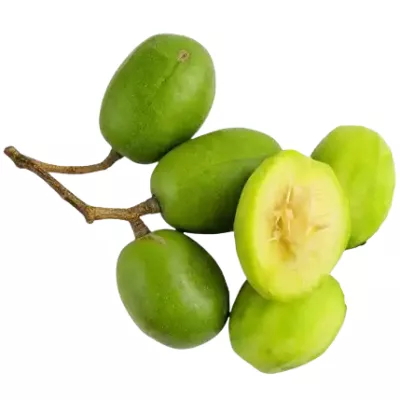



This is a slightly sweet, grafted variety of hog plum, or sweet ambazham. The fruit has very little fibre, unlike the usual hog plums. It is a very practical substitute for mango during seasons where mango may not be available.

Pay using UPI, Card or Netbanking

Shipping within 3 working days
Hog plum, botanically Spondias mombin, is a fibrous oval shaped fruit, which is sour in taste even when ripe. However, the new hybrid varieties of hog plums are much less fibrous. They are also more sweet than sour and are quite edible.
Hog plum is a small to medium sized tree that can grow up to 15 metres tall. It has a dense, spreading canopy, a short boot and rough, grey-brown bark.
However, grafted varieties are very compact and can easily be grown in large pots.
Hog plum thrives in warm climates with temperatures between 20°C and 35°C. The plant prefers well-drained sandy or loamy soils. It tolerates acidic and alkaline soil.
Hog plum prefers full sun, but can also tolerate partial shade.
Hog plum trees from seedlings needs to be planted at a distance of 10 to 12 metres from each other.
However, nowadays only grafted varieties are planted which are much compact. Pruning is recommended to maintain their size and shape.
Spondias mombin trees need regular watering, especially in the dry season. However, it's important not to overwater the plant as this can lead to root rot.
Maintaining Hogplum plants is fairly straightforward. Pruning should be done regularly to keep their shape and size, as well as to remove dead or diseased branches. It is usually devoid of pest attacks.
The fruit of Spondias mombin is oval-shaped, with a smooth, yellow or orange skin that turns orange-red when ripe. The flesh is juicy and fibrous, with a tangy, slightly sweet flavor. The fruit isize is typically 6-8 cm.
Spondias mombin fruit is commonly eaten fresh or cooked.
In fact, it can be used as a substitute for raw mango in most recipes. While most mango varieties are seasonal, hog plums are available round the year.
The fruits from this grafted hog plum are slightly different from the traditional hog plums. Its fruit is not fibrous. When fully ripe, the fruit is not only slightly sweet but also not very sour.
In some regions, it is also used to make a traditional alcoholic beverage.
Hog plums, also known as Spondias mombin, are a nutrient-rich fruit containing high amounts of vitamin C, dietary fiber and antioxidants.
Data sheet